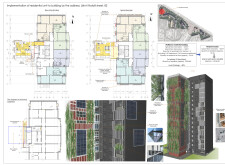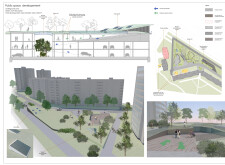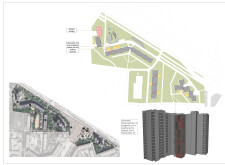5 key facts about this project
### Project Overview
This architectural design involves the development of high-rise apartments located at Uzhvii Natalii Street, 82. The proposal centers on a modular living unit designed to accommodate approximately ten residents within a compact area of 36.8 square meters. It aims to address the increasing demand for efficient housing solutions in densely populated urban environments, while fostering community engagement through thoughtful spatial organization and sustainable practices.
### Spatial Strategy and Community Engagement
The design employs a modular configuration to enhance adaptability and facilitate diverse uses. Prefabricated components streamline the construction process, reducing time and cost. Central to the layout are collaborative spaces, such as shared kitchens and dining areas, that encourage social interaction among residents. The design also incorporates safety features, including designated safe zones and accessible pathways, ensuring a secure environment for all inhabitants.
### Materiality and Sustainability
A range of materials selected for their durability and environmental benefits contributes to the project's sustainability goals. Reinforced concrete serves as the primary structural element, offering strength. Insulation panels enhance energy efficiency, while armored windows and explosion-resistant doors prioritize security without compromising natural light. The inclusion of green façades supports biodiversity, and solar panels facilitate the harnessing of renewable energy resources, thereby minimizing the carbon footprint of the building.
### Public Space and Outdoor Amenities
The design also prioritizes the public realm, integrating outdoor spaces that encourage social interaction and recreational activities. Features such as green roofs serve dual purposes by providing communal areas while also managing stormwater and regulating temperature. Dedicated recreational areas cater to both active and passive uses, enhancing the livability of the environment. The incorporation of landscaped green zones further promotes biodiversity within the urban setting.






















































